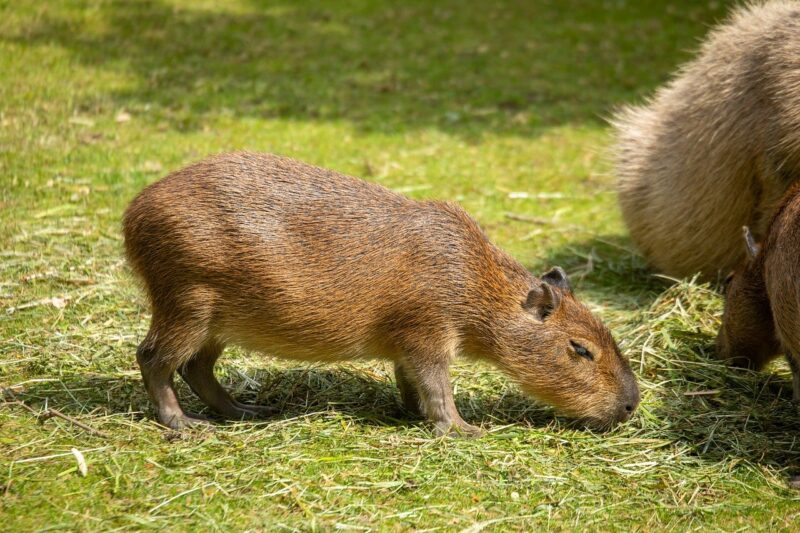Capybaras and Humans: Understanding the Bond Between People and the World’s Largest Rodent
November 13, 2024

Capybaras, often dubbed the world’s largest rodents, stand out not only for their size but also for their remarkable sociability and unique interactions with humans and other animals. Found primarily in the savannas and dense forests of South America, these gentle giants have captured the hearts of many due to their friendly demeanor and engaging behavior. In this article, we will explore the bond between capybaras and humans and understand why these creatures are becoming increasingly popular as pets and icons of animal welfare.
1. The Capybara: An Introduction
Capybaras (Hydrochoerus hydrochaeris) are the largest rodents in the world, weighing anywhere from 77 to 150 pounds and measuring about 4 feet in length. Their distinct features include a broad muzzle, large round bodies, and slightly webbed feet, which help them thrive in semi-aquatic habitats.
In the wild, capybaras are social animals, living in groups that can range from ten to over 100 individuals. They have a highly developed social structure, with strong bonds formed within their groups. This social behavior plays a crucial role in their interactions with humans, as capybaras often display a calm and friendly demeanor towards people.
2. The Evolution of Human-Capybara Relationships
Historically, capybaras have co-existed alongside humans in South America, primarily as livestock animals. In countries like Venezuela and Colombia, they were hunted for their meat and skins, with communities relying on their presence for sustenance and cultural practices. However, as attitudes toward wildlife have evolved, capybaras are increasingly recognized for their gentle nature and environmental significance.
In recent years, a growing movement has seen capybaras brought into homes as pets. Unlike many exotic animals, capybaras are known for their docile temperament, becoming more like companions than traditional pets. This shift has prompted more people to learn how to care for these unique rodents, leading to better awareness of their needs and welfare.
3. Capybaras as Pets: Pros and Cons
Bringing a capybara into your home can be rewarding but also requires careful consideration. Here are some pros and cons of owning a capybara:
- Pros:
- Friendly Nature: Capybaras are affectionate and tend to bond well with their owners and other pets, including dogs and cats.
- Sociable: They thrive in social environments, which can create a lively and interactive atmosphere in your home.
- Low Maintenance: Capybaras require less grooming and maintenance compared to many dog breeds, making them easier to care for in some respects.
- Cons:
- Space Needs: Capybaras need ample space to roam and socialize; apartments may not provide the ideal environment for them.
- Legal Restrictions: Check local laws, as capybara ownership is not allowed in every area due to wildlife regulations.
- Dietary Requirements: Maintaining a proper diet requires knowledge of their nutritional needs, which can involve more effort than traditional pets.
Ultimately, potential owners must weigh these factors when considering a capybara as a pet, ensuring they can meet the animal’s needs for space, companionship, and care.
4. The Emotional Bond Between Capybaras and Humans
The connection people feel with capybaras often stems from their gentle disposition and social habits. Many individuals who own or care for these animals report forming strong emotional ties, often likening their relationships to those with dogs.
4.1. Calming Presence
Capybaras are naturally calm creatures. Spending time with them can have therapeutic effects on humans, promoting relaxation and reducing stress. This calming influence has led them to become popular companions for individuals seeking emotional support.
4.2. Unconditional Affection
Capybaras often show affection by nuzzling or resting their heads against their human companions. This behavior fosters a sense of connection and trust, which further enhances the bond between the two. People enjoy the companionship and the kind-hearted nature of these rodents, leading to joyful interactions.
5. Capybaras in Popular Culture
In recent years, capybaras have gained prominence in popular culture, largely due to their quirky characteristics and social behavior. They have become internet celebrities, with various memes and videos showcasing their interactions with other animals and people. This exposure has contributed to increasing awareness of capybaras as wonderful companions, inspiring many to adopt them while promoting animal rights and conservation efforts.
Moreover, documentaries and wildlife shows frequently feature capybaras, further highlighting their charm and promoting their status as ambassadors for their species. Such representations encourage responsible pet ownership, debunk myths, and educate audiences on the importance of protecting wildlife habitats.
6. The Future of Human-Capybara Relationships
As our understanding of wildlife and animal welfare continues to evolve, the future of human-capybara relationships looks promising. With increasing numbers of individuals recognizing the value of these animals as companions, it’s essential to promote responsible ownership practices and educate potential pet owners about the unique needs of capybaras.
Organizations focused on animal welfare are working tirelessly to ensure that capybaras in captivity receive care aligned with their natural instincts. By fostering understanding around these creatures, humanity can not only create better environments for capybaras but also enrich our own lives through these extraordinary bonds.
Conclusion
The bond between capybaras and humans is a testament to the beauty of animal companionship. Understanding their unique traits and needs can lead to enriching relationships that benefit both parties. Through responsible ownership and education, we can ensure that capybaras, as they become more prevalent in our lives, contribute positively to our well-being and highlight the importance of compassion in our interactions with the animal kingdom. In embracing capybaras, we celebrate not just their charm but also our commitment to coexistence with wildlife, fostering a future where such connections flourish.







